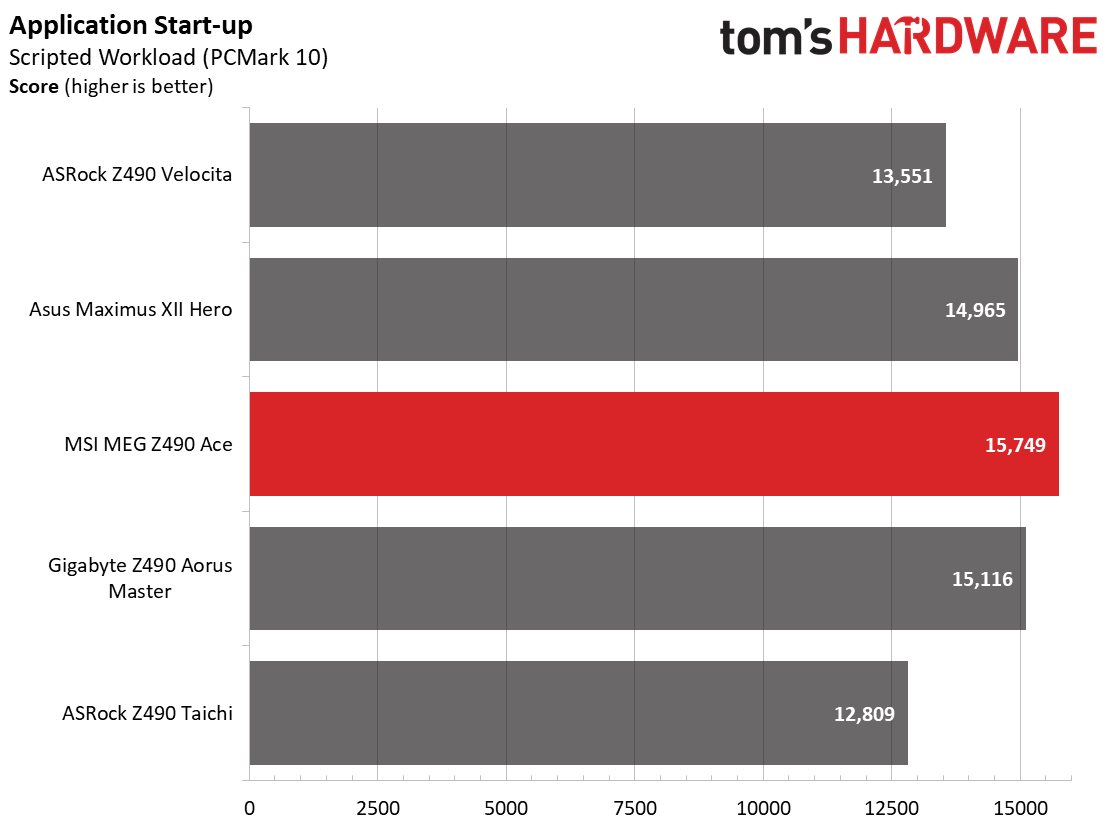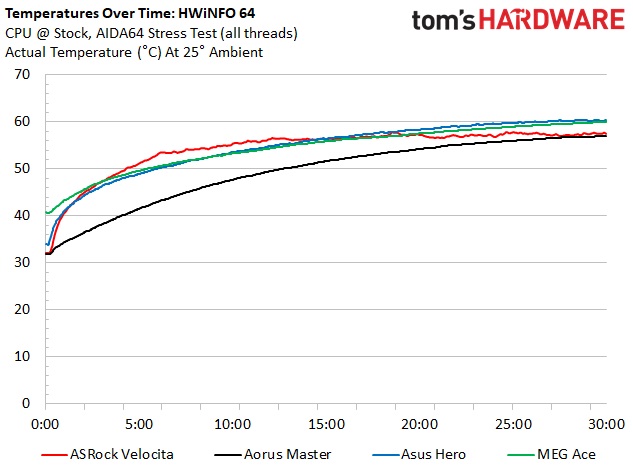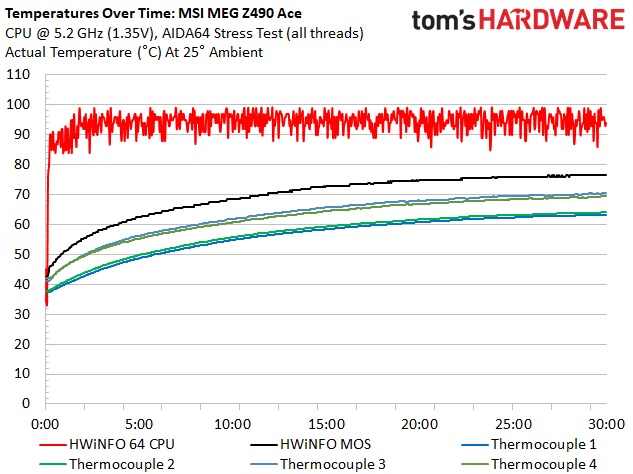Why you can trust Tom's Hardware
Our standard benchmarks and power tests are performed using the CPU’s stock frequencies (including stock Thermal Velocity Boost), with all power-saving features enabled. Optimized defaults are set in the BIOS and the memory is set using the XMP profiles. For this baseline testing, Windows is set to High Performance (power testing uses Balanced so the PC idles properly).
Synthetic Benchmarks
Synthetics are a great tool to figure out if a board is running out of spec, as identical settings should produce similar performance results. Advanced memory timings are the one place where motherboard makers can still optimize for either stability or performance, though, and those settings can impact some testing.





















In our synthetic benchmarks, The Meg Z490 Ace performed well overall, beating other boards in some tests, but not all. No result was out of the expected range for this configuration.
Timed Applications



Our timed applications show the MEG Ace is a bit slower on average versus the Velocita, Taichi, and Hero in the x264 portion of the Handbrake test with little difference in x265. In LAME testing, the MEG Ace was the second slowest, while the Corona benchmark result shows the Ace one second behind.
3D Games and 3DMark




We’ve recently updated our game tests to more modern titles, including The Division 2 and Forza Horizon 4. The games are run at 1920x1080 resolution using the Ultra preset. As the resolution goes up, the CPU tends to have less of an impact and most games at this resolution in the first place. The goal with these settings is to determine if there are differences in performance at the most commonly used resolution with settings most people use or at least strive for.
In both 3DMark tests and the games, the MEG Z490 Ace scores and frames per second landed where expected, close to most other comparable results.
Power Consumption / VRM Temperatures
Our first glimpse of power use for this platform and the 10c/20t i9-10900K may be a bit shocking to some. With loads reaching almost 200W at stock speeds (because the boards allow for higher than intel spec), many users will be hard-pressed to keep these cool and get the most out of the chip. For power testing, we used AIDA64’s System Stability Test with Stress CPU, FPU and Cache enabled using peak power consumption value. The wattage reading is taken from the wall via a Kill-A-Watt meter to capture the entire ecosystem; the only variable that changes is the motherboard -- all other parts are the same..
Get Tom's Hardware's best news and in-depth reviews, straight to your inbox.
The MEG Z490 Ace idled at 55W, jumping to 250W under load. The Actual load wattage for the CPU, according to HWInfo64, was 170W. Load wattage was by far the best on the MEG Ace, but this comes at the expense of slightly lower clocks -- the board ran AIDA64 stress test at 4.8 GHz versus others at 4.9.




For VRM testing, the MEG Z490 Ace worked well, keeping the VRMs within operating parameters at stock and while overclocked. During stock operation, the VRMs peaked at 61 degrees Celsius and while overclocked, they reached 71 degrees Celsius. The overclocked temperatures are the highest from the group of motherboards tested so far, even though there is a small fan in the VRM bank. That said, the fan was inaudible and the operating temperatures remained well within safe parameters.
Overclocking
From our other Z490 motherboard reviews, we know our CPU sample lets us run up to 5.2 GHz at ~1.35V while keeping the CPU somewhere between 90-100 degrees Celsius. The MEG Ace reached our thermally limited overclock without worry. There was a bit of vdroop that was easily mitigated by adjusting the LLC to Turbo.
On the memory side, we swapped out the GSkill Trident Z Neo DDR4 3600 sticks with a Trident Z Royal kit rated at DDR4 4000. Just as with other boards so far, we were unable to stabilize 4x8GB at that speed, but 2x8GB DDR4 4000 wasn’t a problem.
Final Thoughts
MSI’s MEG Z490 Ace is priced at $399.99, which is at the top of this heap along with the Asus ROG Maximus XII Hero (Wi-Fi) priced the same. The Aorus Master, $389.99, and ASRock Z490 Taichi, $369.99, are priced a bit less. By this point, we know all of the tested boards have enough VRM capability to overclock the flagship i9-10900K to its thermal limits. This leaves appearance and features the major deciding factors since performance and price are close together.
When looking at the MEG Z490 Ace, again we see a notable improvement over Z390 desiugns, with additional shrouds covering more of the PCB, giving it a more premium look. The rear backplate adds additional rigidity and weight to the board so it feels like a tank. As far as appearance goes, I prefer the looks of the other boards, but beauty is in the eye of the beholder. That said, the MEG Z490 Ace shouldn’t have much trouble blending in with most build themes, though some of the gold styling may thwart some ideas.
Features and specifications-wise, the MSI MEG Z490 Ace includes what amounts to the same setup as the other boards in this class. You get six SATA ports, three M.2 slots, a faster-than-1 GbE port, along with improved VRMs. The Ace doesn’t have much that sets it apart from the other boards outside of the most robust power delivery (we’ve tested so far) and USB 3.2 Gen 2 (20 Gbps) port.
The concern with this board comes with the price. It is the same price as the Asus ROG Maximus XII Hero, but includes 2.5 GbE LAN (versus 5 GbE) and does not have the ability to monitor water flow and temperature. The Aorus Master can do the latter, and is priced $10 cheaper. The MSI MEG Z490 Ace is a solid board and significant improvement over Z390, but when held up to the light against its competition, the Ace doesn’t shine quite as bright at its current $399.99 price. If you can find it for $20 or so cheaper, the decision between these boards would be far more difficult.
MORE: Best Motherboards
MORE: How To Choose A Motherboard
MORE: All Motherboard Content

Joe Shields is a staff writer at Tom’s Hardware. He reviews motherboards and PC components.

